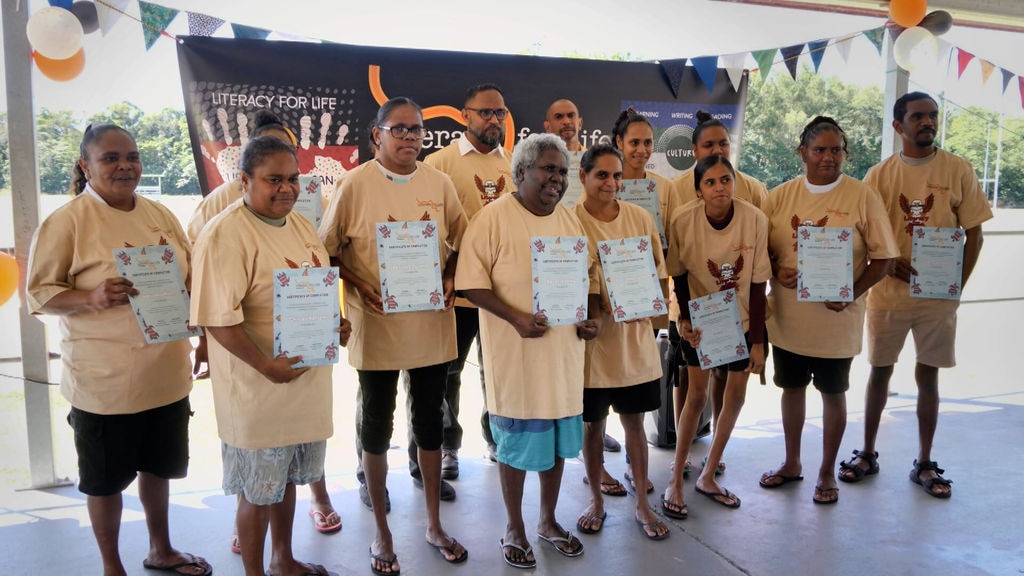A Journey of Literacy and Empowerment
Alton Sands, who left school 30 years ago without the basic reading and writing skills that many Australians consider standard, never imagined his future would involve sitting in a classroom. At 45, he now joins dozens of other adults in his community of Yarrabah, determined to gain the literacy skills they missed out on earlier in life.
“It was pretty complicated and hard,” Mr Sands admitted. “But now, since I’ve come to this course, I really know how to read and write.”
Yarrabah, located about an hour from Cairns, is one of the largest Indigenous communities in Australia. It has also become a hub for the Literacy for Life program, an Aboriginal-led initiative that has helped over 500 adults nationwide achieve functional literacy. As a graduate of the program, Mr Sands plans to return for another term and encourages others to join him.
However, he acknowledges that many people may be hesitant to admit their literacy challenges. “I tried to tell them, break that shame, that barrier in front of you,” he said. “Break that out of the road and you won’t have no fear, all that shame will be gone.”
From Student to Teacher
The Literacy for Life Foundation estimates that between 40 and 70 per cent of Aboriginal adults have low English language literacy, with some remote communities reporting up to 90 per cent. The foundation’s executive director, Jack Beetson, highlights the severity of the issue. “We’ve got whole households that can’t even read the dosage on a Panadol packet,” he said. “Yet our households are also the ones home to more chronic disease than any other section of the community.”
Imagine a household where children, adults, and grandparents are all sick at the same time, and the only way to manage the medication is through memory. If this were any other part of the Australian community, it would be considered a national disaster.
The program, based on a Cuban model called Yo, Sí Puedo (Yes, I Can), began in Wilcannia in Far West New South Wales in 2013. The approach involves Aboriginal and Torres Strait Islander locals delivering content in a way that is tailored to their community.
Dwayne Street’s life changed when he joined the program as a student. Now, the 49-year-old delivers the course to others like Mr Sands. “I’m pretty blessful that I got the opportunity to teach my mob, and hopefully, this will spread right around Australia,” he said.
Initially, the classroom environment was challenging for Mr Street, but he eventually adapted. “As we went on, I got used to it,” he said.
Doing It for the Kids
For many adult learners, returning to the classroom is not just about improving job prospects—it’s about setting an example for their children. Alton Sands, for instance, wants to inspire his 12-year-old daughter, Livvy.
Ashleigh Richards, 26, and her partner Lex Costello graduated from the program in Yarrabah just two weeks after the birth of their third child. “I felt comfortable being around people I know,” Ms Richards said. “When I was at school, I was down in Rockhampton, with hardly no-one I knew.”
The couple wanted to improve their literacy to better support their children with reading and homework. According to Literacy for Life Foundation director Wendy Ludwig, many adults who lack basic literacy skills develop coping mechanisms, such as taking forms home to be filled out by others.
“It’s very difficult for people, after having developed those skills and strategies… to then say, ‘I actually need help and I want to learn how to do it myself,'” Dr Ludwig said.
Funding Challenges
In 2013, the foundation estimated that eradicating functional illiteracy in Indigenous communities would cost $1.3 billion over 10 to 15 years. However, over the past decade, the program has operated on a “piecemeal” basis, relying on funding that becomes available in different communities.
Recently, Literacy for Life secured federal funding to continue for another four years in Yarrabah and expand to Cairns, Mossman, and Mapoon in Far North Queensland. Despite a high course completion rate of 59 per cent—much higher than mainstream government-funded initiatives for First Nations adults—the program has never received long-term funding to expand more broadly.
Dr Ludwig emphasizes the importance of having one literate person in a household, which creates a ripple effect on others, especially young people. “By having one literate person in a household, that then has a ripple effect on other people living in that house, and especially in terms of being able to support and help nurture young people,” she said.
She also highlights the need for changes in schools, such as teaching Indigenous students English as a second language rather than framing them as “bad speakers” of English.
A spokesperson for the federal Department of Employment and Workplace Relations stated the government is committed to improving literacy outcomes for all communities, including First Nations. The redesigned Skills for Education and Employment (SEE) program aims to help up to 2,200 First Nations people access free English language, literacy, numeracy, and digital literacy training annually by 2027. The program, which provided Literacy for Life $12 million for its Far North Queensland courses, requires organisations to demonstrate true community support and experience delivering such training to First Nations people.







